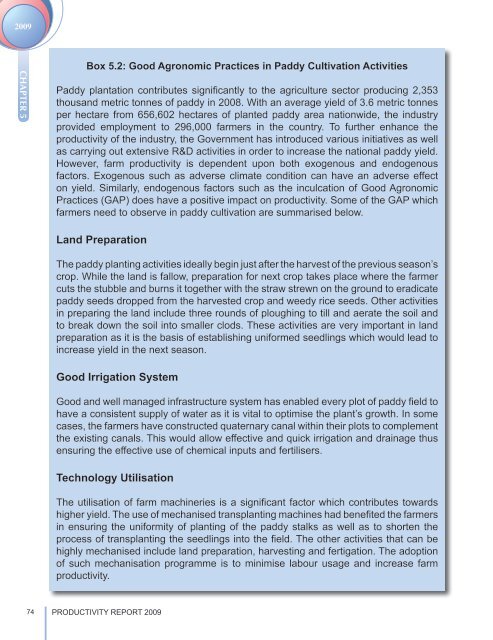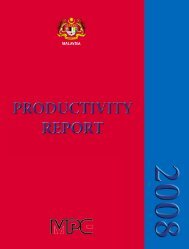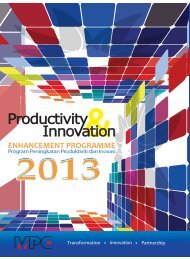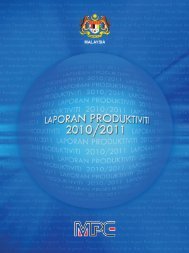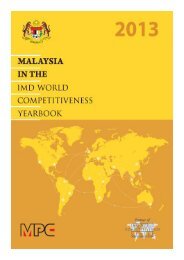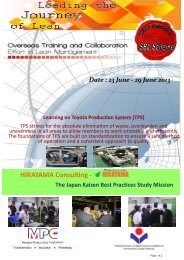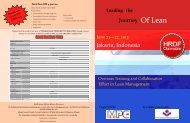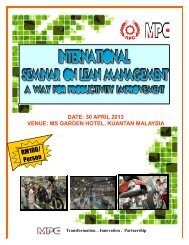Overview - MPC
Overview - MPC
Overview - MPC
Create successful ePaper yourself
Turn your PDF publications into a flip-book with our unique Google optimized e-Paper software.
2009<br />
CHAPTER 5<br />
Box 5.2: Good Agronomic Practices in Paddy Cultivation Activities<br />
Paddy plantation contributes significantly to the agriculture sector producing 2,353<br />
thousand metric tonnes of paddy in 2008. With an average yield of 3.6 metric tonnes<br />
per hectare from 656,602 hectares of planted paddy area nationwide, the industry<br />
provided employment to 296,000 farmers in the country. To further enhance the<br />
productivity of the industry, the Government has introduced various initiatives as well<br />
as carrying out extensive R&D activities in order to increase the national paddy yield.<br />
However, farm productivity is dependent upon both exogenous and endogenous<br />
factors. Exogenous such as adverse climate condition can have an adverse effect<br />
on yield. Similarly, endogenous factors such as the inculcation of Good Agronomic<br />
Practices (GAP) does have a positive impact on productivity. Some of the GAP which<br />
farmers need to observe in paddy cultivation are summarised below.<br />
Land Preparation<br />
The paddy planting activities ideally begin just after the harvest of the previous season’s<br />
crop. While the land is fallow, preparation for next crop takes place where the farmer<br />
cuts the stubble and burns it together with the straw strewn on the ground to eradicate<br />
paddy seeds dropped from the harvested crop and weedy rice seeds. Other activities<br />
in preparing the land include three rounds of ploughing to till and aerate the soil and<br />
to break down the soil into smaller clods. These activities are very important in land<br />
preparation as it is the basis of establishing uniformed seedlings which would lead to<br />
increase yield in the next season.<br />
Good Irrigation System<br />
Good and well managed infrastructure system has enabled every plot of paddy field to<br />
have a consistent supply of water as it is vital to optimise the plant’s growth. In some<br />
cases, the farmers have constructed quaternary canal within their plots to complement<br />
the existing canals. This would allow effective and quick irrigation and drainage thus<br />
ensuring the effective use of chemical inputs and fertilisers.<br />
Technology Utilisation<br />
The utilisation of farm machineries is a significant factor which contributes towards<br />
higher yield. The use of mechanised transplanting machines had benefited the farmers<br />
in ensuring the uniformity of planting of the paddy stalks as well as to shorten the<br />
process of transplanting the seedlings into the field. The other activities that can be<br />
highly mechanised include land preparation, harvesting and fertigation. The adoption<br />
of such mechanisation programme is to minimise labour usage and increase farm<br />
productivity.<br />
74<br />
PRODUCTIVITY REPORT 2009


